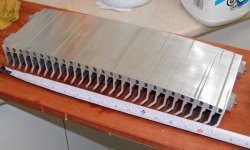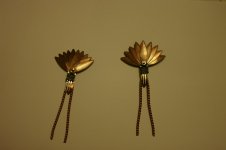I'm thinking to build a pipe heatsink like those design for computer cpu. Copper pipe from hardware store is cheap. Take an aluminium plate, make grooves in it and solder or epoxy the pipe in he groove. Then mount aluminium fins in the pipe. Somebody have try it ?
A heatpipe works with a liquid inside the tube which has very precise specifications. It should evaporate and recondense at the right temperature. Not sure you can get that working ...
Akira you'r right, just read it on wiki. But it may be a fun experiment, we can use alcool , water...for the liquid. The problem is how to make a vacuum in the pipe
It might not be exactly a DIY heatsink, but a tweaked one: has anyone used computer CPU heatsinks, either air-cooled one or water-cooled one for audio amps?
Doug
Doug
Hope someone could offer a circuit & device which can transform the Class-A heat to electric power. We may still need a heatsink, but much smaller. Even we can reduce some electric bill.
I believe transforming the class-A heat to electric power is not easy (if possible), but there have been a lot of efforts to make use of the heat. I remember one time I saw somebody cooking scrambled egg on Aleph amps.
Using them to heat your home in the winter--OK, maybe just a room or two 🙂 --is plenty good. I think that if we were to use water cooling we could preheat our hot-water supply. Now, that's really putting class A to good use!
Here's an idea I didn't see in this recently resurrected thread. It's the way Jungson does it in their JA88D-09 amp, and consists of a bunch of thin stacked copper plates, with smaller copper spacers in the middle. The power transistors themselves are on thicker copper plates spaced out in the array. The stack is laid on its side. Might work in aluminum, if you had some thick and thin sheeting, and a table saw to cut it.
Pictures at (scroll down):
JungSonJA88D-09
PS. if you are into speaker DIY, and can afford nice Danish and Norwegian drivers and fancy caps and coils, Troels Gravesen is the man! (That is, if you don't follow Nelson's journey down the full-range-plus path 😉.)
Pictures at (scroll down):
JungSonJA88D-09
PS. if you are into speaker DIY, and can afford nice Danish and Norwegian drivers and fancy caps and coils, Troels Gravesen is the man! (That is, if you don't follow Nelson's journey down the full-range-plus path 😉.)
Thermocouples are too inefficient and require too much of a thermal differential to be of any practical use.
I've seen the stacked copper idea before using copper roof flashing. Very effective but required a fan to get air between the fins and the heat required to solder the whole thing together (about 6x6") was...nontrivial. Half an hour with a torch and an insulator was required IIRC.
If you want to DIY your own heat pipe cooler:
Benchtest.Com - Heat Pipe 1
Passive Thermosyphon | Overclockers
CPU Vapor Cooling Thermosyphon | Overclockers
I've seen the stacked copper idea before using copper roof flashing. Very effective but required a fan to get air between the fins and the heat required to solder the whole thing together (about 6x6") was...nontrivial. Half an hour with a torch and an insulator was required IIRC.
If you want to DIY your own heat pipe cooler:
Benchtest.Com - Heat Pipe 1
Passive Thermosyphon | Overclockers
CPU Vapor Cooling Thermosyphon | Overclockers
If you want to DIY your own heat pipe cooler:
Benchtest.Com - Heat Pipe 1
Passive Thermosyphon | Overclockers
CPU Vapor Cooling Thermosyphon | Overclockers
Thanks for the links, very educative. Finally, I think a more efficient solution is to buy some cheap used cpu pipe heat sink and find an elegant way to mount them on the chassis.
...I've seen the stacked copper idea before using copper roof flashing. Very effective but required a fan to get air between the fins and the heat required to solder the whole thing together (about 6x6") was...nontrivial. Half an hour with a torch and an insulator was required IIRC...
What i liked about the Jungson version of stacked copper is there is no evidence of solder at all. Probably there is a central hole and a long bolt through all. Also, it might scale up to aluminum reasonably well. If the copper squares are 10cm per side, to double surface area only requires something between 14 and 15cm per side. Troels says the amp idles at about 170 watts and barely gets warm to the touch.
small heatsinks.
sorry for the dark picture, but i am playing around with small heatsinks for one of my next projects.
it wil be a balanced zen pre. i whill be making it point to point with the inside viewable though a partly glass front.
now the question is, what looks better and what will work better?
the left or the right?
and most of all, will it dissipate enough heat?
both are copper blades of about 3.5cm long and 1cm wide the thickness is les than 1mm.
sorry for the dark picture, but i am playing around with small heatsinks for one of my next projects.
it wil be a balanced zen pre. i whill be making it point to point with the inside viewable though a partly glass front.
now the question is, what looks better and what will work better?
the left or the right?
and most of all, will it dissipate enough heat?
both are copper blades of about 3.5cm long and 1cm wide the thickness is les than 1mm.
Attachments
Taking "Steam Punk" to the circuit board level! Will the case also be punk'd?
I like the look of the one on the right better, but I am known for my need for symmetry. Not a thermo engineer, but as long as there is good conductivity between leaves they should work equally well.
If the pieces aren't soldered together, follow Andrew's advice and apply thermalk paste.
Have you sourced circuit boards that look wooden or at least antiqued metal? That would be fun, too.
I like the look of the one on the right better, but I am known for my need for symmetry. Not a thermo engineer, but as long as there is good conductivity between leaves they should work equally well.
If the pieces aren't soldered together, follow Andrew's advice and apply thermalk paste.
Have you sourced circuit boards that look wooden or at least antiqued metal? That would be fun, too.
to answer ANDREWT no, there is no thermal paste, all parts are soldered together.
BOBELLIS the term STEAM PUNK is new for me, but considering the rest of your reaction, i think it is a compliment, thanx.
and yes, the case will be "punk'd" to.
the side's and top cover will be cherry wood, in the top cover there will be two round glass panels, the front will be glass. on the bottom of the case i will place a mirror on the mirror i want to place two pieces of thick Plexiglas (lexan) as i am not going to use PCB i will do point to point, but with a little twist. i'll be using the original layout that NP designed, but i want to make it in to a 3d puzzle, i'll drill holes in the plexiglas and let all the parts hover above the mirror on a twisted copper frame.
the rear panel will be a mirror to on the inside, not real glass
sorry, i can not tell it better than that and i could not draw it to save my live, but i see it in my head and i think it will look great,.... at least i hope it will, i'll be posting photo's.
BOBELLIS the term STEAM PUNK is new for me, but considering the rest of your reaction, i think it is a compliment, thanx.
and yes, the case will be "punk'd" to.
the side's and top cover will be cherry wood, in the top cover there will be two round glass panels, the front will be glass. on the bottom of the case i will place a mirror on the mirror i want to place two pieces of thick Plexiglas (lexan) as i am not going to use PCB i will do point to point, but with a little twist. i'll be using the original layout that NP designed, but i want to make it in to a 3d puzzle, i'll drill holes in the plexiglas and let all the parts hover above the mirror on a twisted copper frame.
the rear panel will be a mirror to on the inside, not real glass
sorry, i can not tell it better than that and i could not draw it to save my live, but i see it in my head and i think it will look great,.... at least i hope it will, i'll be posting photo's.
Boatbuilder: I'm not a thermal engineer either, but it appears to me that the symmetrical one on the right might expose more surface area to the air?
But I can also imagine bending the fins so they fan out in the horizontal plane (if they will be mounted in that orientation).
Why did you use that teardrop shape?
But I can also imagine bending the fins so they fan out in the horizontal plane (if they will be mounted in that orientation).
Why did you use that teardrop shape?
Andersonix.
i forget to bend the teardop shaped blades for the photo, but thy will be bend out before use.
why the teardrop shape, to be honest, i've got about 3 kilo's of those blades.
thy are cut outs from internal heaters.
originally i planned to make a small indoor fountain with them, stick them on a tube as fish scales.
i think this will be a better use.
i forget to bend the teardop shaped blades for the photo, but thy will be bend out before use.
why the teardrop shape, to be honest, i've got about 3 kilo's of those blades.
thy are cut outs from internal heaters.
originally i planned to make a small indoor fountain with them, stick them on a tube as fish scales.
i think this will be a better use.
- Status
- Not open for further replies.
- Home
- Amplifiers
- Pass Labs
- DIY heatsinks

